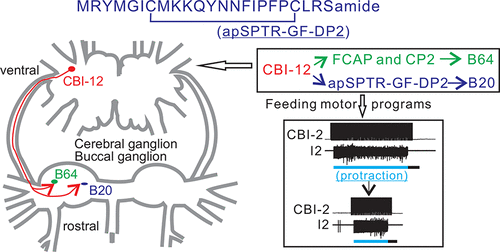当前位置:
X-MOL 学术
›
ACS Chem. Neurosci.
›
论文详情
Our official English website, www.x-mol.net, welcomes your feedback! (Note: you will need to create a separate account there.)
Newly Identified Aplysia SPTR-Gene Family-Derived Peptides: Localization and Function
ACS Chemical Neuroscience ( IF 5 ) Pub Date : 2018-03-15 00:00:00 , DOI: 10.1021/acschemneuro.7b00513 Guo Zhang 1 , Wang-ding Yuan 1 , Ferdinand S. Vilim 2 , Elena V. Romanova 3 , Ke Yu 1 , Si-yuan Yin 1 , Zi-wei Le 1 , Ying-yu Xue 1 , Ting-ting Chen 1 , Guo-kai Chen 1 , Song-an Chen 1 , Elizabeth C. Cropper 2 , Jonathan V. Sweedler 3 , Klaudiusz R. Weiss 2 , Jian Jing 1, 2
ACS Chemical Neuroscience ( IF 5 ) Pub Date : 2018-03-15 00:00:00 , DOI: 10.1021/acschemneuro.7b00513 Guo Zhang 1 , Wang-ding Yuan 1 , Ferdinand S. Vilim 2 , Elena V. Romanova 3 , Ke Yu 1 , Si-yuan Yin 1 , Zi-wei Le 1 , Ying-yu Xue 1 , Ting-ting Chen 1 , Guo-kai Chen 1 , Song-an Chen 1 , Elizabeth C. Cropper 2 , Jonathan V. Sweedler 3 , Klaudiusz R. Weiss 2 , Jian Jing 1, 2
Affiliation

|
When individual neurons in a circuit contain multiple neuropeptides, these peptides can target different sets of follower neurons. This endows the circuit with a certain degree of flexibility. Here we identified a novel family of peptides, the Aplysia SPTR-Gene Family-Derived peptides (apSPTR-GF-DPs). We demonstrated apSPTR-GF-DPs, particularly apSPTR-GF-DP2, are expressed in the Aplysia CNS using immunohistochemistry and MALDI-TOF MS. Furthermore, apSPTR-GF-DP2 is present in single projection neurons, e.g., in the cerebral-buccal interneuron-12 (CBI-12). Previous studies have demonstrated that CBI-12 contains two other peptides, FCAP/CP2. In addition, CBI-12 and CP2 promote shortening of the protraction phase of motor programs. Here, we demonstrate that FCAP shortens protraction. Moreover, we show that apSPTR-GF-DP2 also shortens protraction. Surprisingly, apSPTR-GF-DP2 does not increase the excitability of retraction interneuron B64. B64 terminates protraction and is modulated by FCAP/CP2 and CBI-12. Instead, we show that apSPTR-GF-DP2 and CBI-12 increase B20 excitability and B20 activity can shorten protraction. Taken together, these data indicate that different CBI-12 peptides target different sets of pattern-generating interneurons to exert similar modulatory actions. These findings provide the first definitive evidence for SPTR-GF’s role in modulation of feeding, and a form of molecular degeneracy by multiple peptide cotransmitters in single identified neurons.
中文翻译:

新鉴定的海藻SPTR基因家族衍生的肽:本地化和功能。
当回路中的单个神经元包含多个神经肽时,这些肽可以靶向不同组的跟随神经元。这使电路具有一定程度的灵活性。在这里,我们确定了一个新的肽家族,即Aplysia SPTR基因家族衍生肽(apSPTR-GF-DPs)。我们证明apSPTR-GF-DPS,特别apSPTR-GF-DP2,在表示海兔使用免疫组织化学和MALDI-TOF MS的中枢神经系统。此外,apSPTR-GF-DP2存在于单个投射神经元中,例如在脑颊中神经元12(CBI-12)中。先前的研究表明,CBI-12还包含另外两种肽FCAP / CP2。此外,CBI-12和CP2可以缩短运动程序的延长阶段。在这里,我们证明FCAP缩短了拖延时间。此外,我们显示apSPTR-GF-DP2也缩短了拖延时间。令人惊讶的是,apSPTR-GF-DP2不会增加回缩中神经元B64的兴奋性。B64终止延迟,并由FCAP / CP2和CBI-12进行调制。相反,我们显示apSPTR-GF-DP2和CBI-12增加了B20的兴奋性,而B20的活性则可以缩短延长时间。在一起 这些数据表明,不同的CBI-12肽靶向不同的模式生成中间神经元集,以发挥相似的调节作用。这些发现为SPTR-GF在调节饲喂中的作用提供了第一个明确的证据,并通过单个识别的神经元中的多种肽共递质形成了分子简并性形式。
更新日期:2018-03-15
中文翻译:

新鉴定的海藻SPTR基因家族衍生的肽:本地化和功能。
当回路中的单个神经元包含多个神经肽时,这些肽可以靶向不同组的跟随神经元。这使电路具有一定程度的灵活性。在这里,我们确定了一个新的肽家族,即Aplysia SPTR基因家族衍生肽(apSPTR-GF-DPs)。我们证明apSPTR-GF-DPS,特别apSPTR-GF-DP2,在表示海兔使用免疫组织化学和MALDI-TOF MS的中枢神经系统。此外,apSPTR-GF-DP2存在于单个投射神经元中,例如在脑颊中神经元12(CBI-12)中。先前的研究表明,CBI-12还包含另外两种肽FCAP / CP2。此外,CBI-12和CP2可以缩短运动程序的延长阶段。在这里,我们证明FCAP缩短了拖延时间。此外,我们显示apSPTR-GF-DP2也缩短了拖延时间。令人惊讶的是,apSPTR-GF-DP2不会增加回缩中神经元B64的兴奋性。B64终止延迟,并由FCAP / CP2和CBI-12进行调制。相反,我们显示apSPTR-GF-DP2和CBI-12增加了B20的兴奋性,而B20的活性则可以缩短延长时间。在一起 这些数据表明,不同的CBI-12肽靶向不同的模式生成中间神经元集,以发挥相似的调节作用。这些发现为SPTR-GF在调节饲喂中的作用提供了第一个明确的证据,并通过单个识别的神经元中的多种肽共递质形成了分子简并性形式。


























 京公网安备 11010802027423号
京公网安备 11010802027423号